 delawarensis Ring-billed Gull delawarensis Ring-billed Gull
(last update:
10-03-2014
) |
Coordinators:
Keith Mueller
Amar Ayyash
Mars Muusse
Index ORG
ring projects
PDF's
1cy June
1cy July
1cy Aug
1cy Sept
1cy Oct
1cy Nov
1cy Dec
2cy Jan
2cy Feb
2cy March
2cy April
2cy May
2cy June
2cy July
2cy Aug
2cy Sept
2cy Oct
2cy Nov
2cy Dec
3cy Jan
3cy Feb
3cy March
3cy April
3cy May
3cy June
3cy July
3cy Aug
3cy Sept
adult Jan
adult Feb
adult March
adult April
adult May
adult June
adult July
adult Aug
adult Sept
adult Oct
adult Nov
adult Dec |
1st cycle (2CY): February
Ring-billed Gull - Larus delawarensis. Description in "Gulls of North America, Europe, and Asia", by Klaus Malling Olsen & Hans Larsson, Princeton University Press.
This is a copy of the chapter on Ring-billed Gull, written by Klaus Malling Olsen. "I" in the text refer to the author. If you find any errors, please let me know at marsmuusse at gmail dot com.
Ring-billed Gull - Larus delawarensis
part 1: IDENTIFICATION of ADULT
below part 2: IDENTIFICATION of JUVENILE
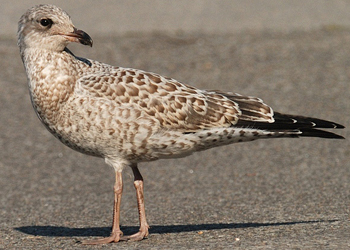 |
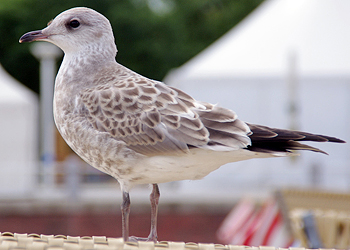 |
| Ring-billed Gull delawarensis juvenile, July 13 2012, Cote Ste-Catherine, Canada (Julie Tremblay). |
Common Gull canus juvenile, July 19 2012, Travemunde Strand, Germany (Charles Swift). |
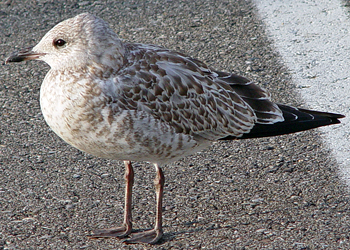 |
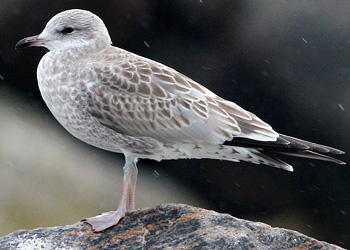 |
| Ring-billed Gull delawarensis juvenile, August 08 2003, Ann Arbor, Michigan (Thomas Rumley). |
Common Gull canus juvenile, August 10 2013, Hirtshals Havn, Denmark (Hendrik Pedersen). |
Juvenile
Similar to Common Gull; see detailed description.
First winter / First cycle
Develops first-winter plumage from early autumn. Separation from Common can be tricky. Some (males) are larger with a squarer head and heavier, more parallel-edged bill than any Common; small females differ barely in jizz from average Common Gull. Compared to Common Gull canus/heinei and Mew Gulls, upperparts generally more contrasting and, importantly, mantle always paler.
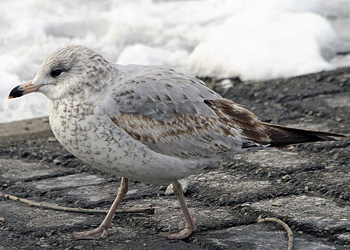 |
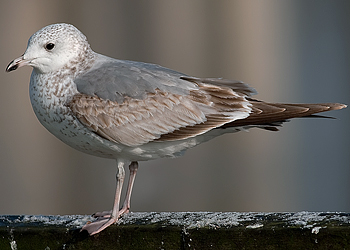 |
| Ring-billed Gull delawarensis 1st cycle, January 22 2012, Burlington, Canada (Miriam Bauman). |
Common Gull canus 1st cycle, January 29 2011, Leiderdorp, The Netherlands (Maarten van Kleinwee). |
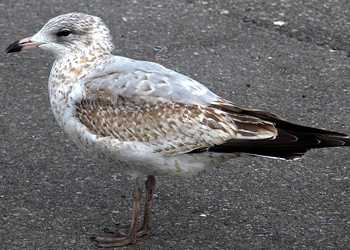 |
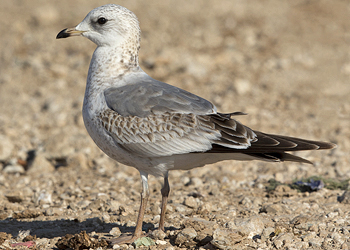 |
| Ring-billed Gull delawarensis 1st cycle, January 10 2013, Florida (Christine Dodding). |
Common Gull heinei 1st cycle, December 21 2013, Evron Dump, Israel (Amir Ben Dov). |
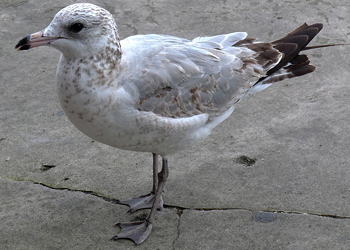 |
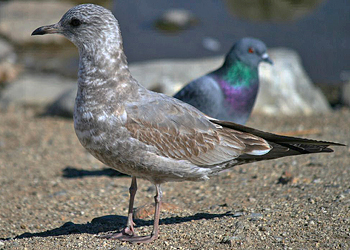 |
| Ring-billed Gull delawarensis 1st cycle, January 19 2013, Florida (Christine Dodding). |
Mew Gull brachyrhynchus 1st cycle, October 31 2011, Virginia Lake (Kirk Zufelt). |
_RWD2.jpg) |
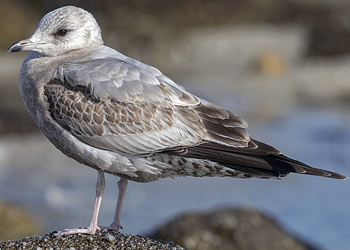 |
| Ring-billed Gull delawarensis 1st cycle, February 14 2007, North Carolina (Dick Daniels). |
Mew Gull brachyrhynchus 1st cycle, January 21 2014, Point Pinos, CA. (Hawk person). |
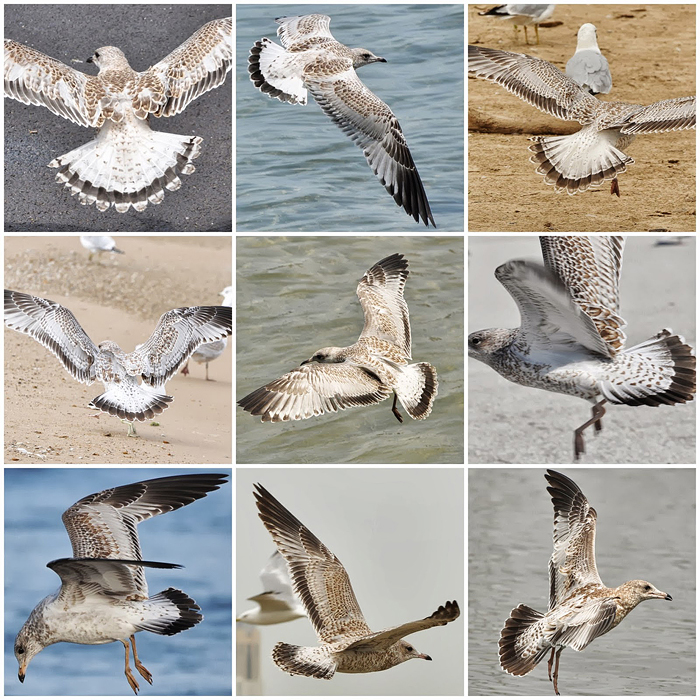
Variation in Ring-billed Gull tail-bands (click to enlarge).
There are eight important characters to look for.
(1) Tail pattern. In Ring-billed most varying, but typically with less clear-cut tail-bar and usually extra tail-bands. 5-7% show clear-cut tail-bar as in Common Gull (which shows little variation in tail-bar), but usually with grey tinge to T5-6. Only exceptionally tail appears almost uniform dark as in Mew Gull.
(2) Greater coverts. In Ring-billed these are pale grey, concolorous with the mantle, normally with dark transverse bars on especially innermost greater coverts. In Common and Mew Gull, greater coverts brownish-grey, paler and browner than mantle. This presents a useful character until wear in early spring makes greater coverts strongly bleached in Common and Mew Gulls.
(3) Median coverts. These are usually with more triangular dark bases creating a weaker and more diffuse pattern than in Common Gull, in which the centres of the median coverts are normally rounded; Mew and certain E Asian Common Gulls have median coverts closer to Ring-billed. Median coverts of Ring-billed wear quicker: from autumn, pale edges are often worn off and the pattern diluted. In Common and Mew the strong pattern is retained better throughout the winter.
(4) Bill. Bill is stouter, parallel-edged (i.e. rectangular) with a stronger-hooked tip, and strongly bicoloured, having a pinkish base and black tip, often recalling a first-year Glaucous Gull. Weaker bill of Common and Mew deeper at base than at more gently curved tip, and often with a less clear division between black and pale. Coloration in Common duller but variable (unlike Ring-billed): dull pink, pale yellow or grey with fleshy, yellow or greenish tinge.
(5) Dark patterning on head and breast. In Ring-billed this is generally more extensive, with broader and denser streaks or spots and a more distinctly spotted hindneck. Flanks to undertail-coverts with broad blackish chevrons. Heavily marked birds may have crown, eye surroundings and sides of neck and breast so densely marked as to look almost uniform around wing-bend. White eye-crescents often conspicuous. Common Gull is typically less extensively marked on head and underparts; more heavily marked Common Gulls have more distinct streaks and paler flanks, at most with narrower and clear-cut dark chevrons. Mew Gull has a rather uniform, pale brown hindneck and underparts, and strongly brown-barred undertail-coverts. Both Common and Mew Gull lack distinct white eye-crescents.
(6) Tertials. These are generally less full with narrower white edges than Common Gull. Edges often with irregular pattern, at tips sometimes similar to Herring Gull. Often strongly worn from winter onwards (usually less so in Common).
(7) Mantle. This is pale grey (as adult), often with broader dark and pale scaling than in all but extremely well-marked Common Gull (evident into midwinter). Some have diagnostic dark subterminal spots, creating pattern similar to juvenile Red Knot Calidris canutus, or narrow dark shaft-streaks or spots intermixed. In Common and Mew Gulls mantle darker and normally cleaner grey, rarely with pale edges. Some Common populations (especially of kamtschatschensis) retain much of juvenile plumage in first-winter.
(8) Underwing. This often shows a large pale midwing-panel: axillaries and greater coverts have narrower dark tips than Common. In midwinter, white on underwing contrasts well with dark secondaries, and underwing may appear as pale as in Mediterranean Gull. Most Common Gulls show more evenly dark pattern on underwing, and kamtschatschensis often has solid dark underwing-coverts; the same is true for most Mew Gulls.
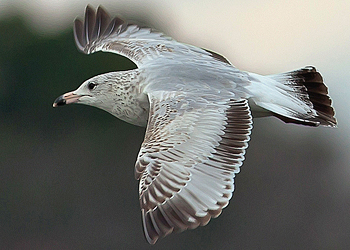 |
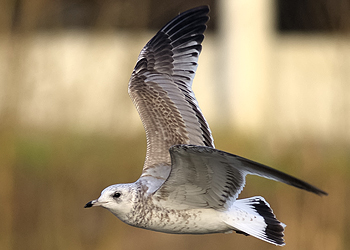 |
| Ring-billed Gull delawarensis 1st cycle, December 30 2012, Cross Lake, Louisiana (Ronnie Maum). |
Common Gull canus J9JZ 1st cycle, December 30 2012, Leiden, The Netherlands (Maarten van Kleinwee). |
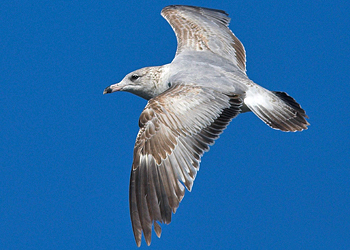 |
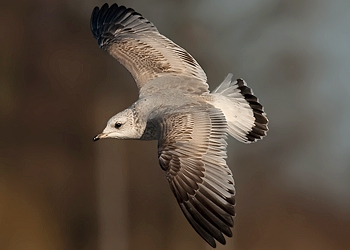 |
| Ring-billed Gull delawarensis 1st cycle, February 07 2007, Orlando, FL. (Patricia Ferguson). |
Common Gull canus 1st cycle, January 02 2011, Warmond, The Netherlands (Maarten van Kleinwee). |
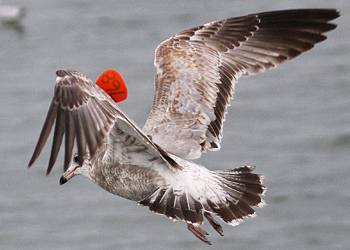 |
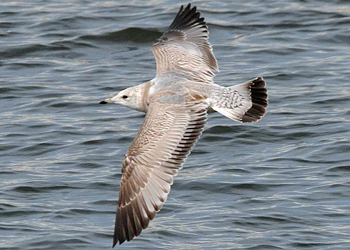 |
| Ring-billed Gull delawarensis 768 1st cycle, January 12 2013, New Haven Harbor, New Haven, CT. (Keith Mueller). |
Common Gull kamtschatschensis 1st cycle, February 25 2011, Choshi, Japan (Clive Harris). |
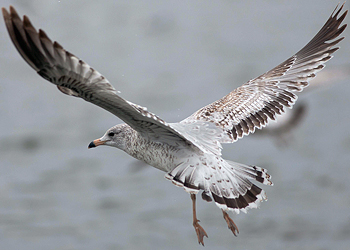 |
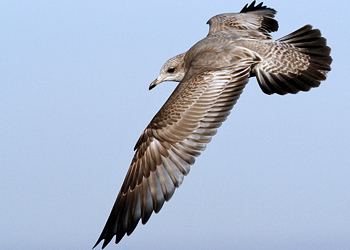 |
| Ring-billed Gull delawarensis 1st cycle, December 30 2012, Cross Lake, Louisiana (Ronnie Maum). |
Mew Gull brachyrhynchus 1st cycle, January 15 2011, Off San Luis Obispo Co. (Brad Schram). |
CONTINUE PART 3: IDENTIFICATION of 1ST SUMMER - 3RD WINTER |
 Ring-billed Gull delawarensis 226 1st cycle (2CY), February 20 2010, West Haven boat ramp, West Haven, CT. Picture: Keith Mueller. Ring-billed Gull delawarensis 226 1st cycle (2CY), February 20 2010, West Haven boat ramp, West Haven, CT. Picture: Keith Mueller. |
 Ring-billed Gull delawarensis 705 1st cycle (2CY), February 16 2013, Bayonne, NJ. Picture: Suzanne Hill. Ring-billed Gull delawarensis 705 1st cycle (2CY), February 16 2013, Bayonne, NJ. Picture: Suzanne Hill. |
 Ring-billed Gull delawarensis X05 1st cycle (2CY), February 08 & March 08 2015, Mill Pond - Wantagh, Long Island, NY, USA. Picture: Beth Fishkind. Ring-billed Gull delawarensis X05 1st cycle (2CY), February 08 & March 08 2015, Mill Pond - Wantagh, Long Island, NY, USA. Picture: Beth Fishkind. |
 Ring-billed Gull delawarensis 1st cycle (2CY), February 26 2012, North Point Marina - Lake Co., IL. Picture: Amar Ayyash. Ring-billed Gull delawarensis 1st cycle (2CY), February 26 2012, North Point Marina - Lake Co., IL. Picture: Amar Ayyash. |
_RWD2.jpg) Ring-billed Gull delawarensis 1st cycle (2CY), February 14 2007, North Carolina, USA. Picture: Dick Daniels. Ring-billed Gull delawarensis 1st cycle (2CY), February 14 2007, North Carolina, USA. Picture: Dick Daniels. |
 Ring-billed Gull delawarensis 1st cycle (2CY), February 22 2014, Edisto Island, SC. Picture: Gary Casey. Ring-billed Gull delawarensis 1st cycle (2CY), February 22 2014, Edisto Island, SC. Picture: Gary Casey. |
 Ring-billed Gull delawarensis 1st cycle (2CY), February 03 2013, Oyster Point Marina, San Mateo Co., CA. Picture: Ken Schneider. Ring-billed Gull delawarensis 1st cycle (2CY), February 03 2013, Oyster Point Marina, San Mateo Co., CA. Picture: Ken Schneider. |
 Ring-billed Gull delawarensis 1st cycle (2CY), February 13 2014, BP Whiting refinery, IN. Picture: Maarten van Kleinwee. Ring-billed Gull delawarensis 1st cycle (2CY), February 13 2014, BP Whiting refinery, IN. Picture: Maarten van Kleinwee. |
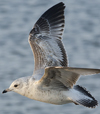 Ring-billed Gull delawarensis 1st cycle (2CY), February 13 2014, BP Whiting refinery, IN. Picture: Maarten van Kleinwee. Ring-billed Gull delawarensis 1st cycle (2CY), February 13 2014, BP Whiting refinery, IN. Picture: Maarten van Kleinwee. |
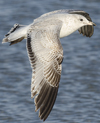 Ring-billed Gull delawarensis 1st cycle (2CY), February 13 2014, BP Whiting refinery, IN. Picture: Maarten van Kleinwee. Ring-billed Gull delawarensis 1st cycle (2CY), February 13 2014, BP Whiting refinery, IN. Picture: Maarten van Kleinwee. |
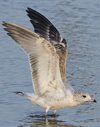 Ring-billed Gull delawarensis 1st cycle (2CY), February 13 2014, BP Whiting refinery, IN. Picture: Maarten van Kleinwee. Ring-billed Gull delawarensis 1st cycle (2CY), February 13 2014, BP Whiting refinery, IN. Picture: Maarten van Kleinwee. |
 Ring-billed Gull delawarensis 1st cycle (2CY), February 16 2014, BP Whiting refinery, IN. Picture: Maarten van Kleinwee. Ring-billed Gull delawarensis 1st cycle (2CY), February 16 2014, BP Whiting refinery, IN. Picture: Maarten van Kleinwee. |
 Ring-billed Gull delawarensis 1st cycle (2CY), February 07 2007, Orlando, FL. Picture: Patricia Ferguson. Ring-billed Gull delawarensis 1st cycle (2CY), February 07 2007, Orlando, FL. Picture: Patricia Ferguson. |
 Ring-billed Gull delawarensis 1st cycle (2CY), February 10 2014, Limerick, Ireland. Picture: Tom Tarpey. Ring-billed Gull delawarensis 1st cycle (2CY), February 10 2014, Limerick, Ireland. Picture: Tom Tarpey. |
 Ring-billed Gull delawarensis 1st cycle (2CY), February 13 2014, BP Whiting refinery, IN. Picture: Maarten van Kleinwee. Ring-billed Gull delawarensis 1st cycle (2CY), February 13 2014, BP Whiting refinery, IN. Picture: Maarten van Kleinwee. |
| |
| |
| |
| |
| |
|
 Ring-billed Gull delawarensis 226 1st cycle (2CY), February 20 2010, West Haven boat ramp, West Haven, CT. Picture: Keith Mueller.
Ring-billed Gull delawarensis 226 1st cycle (2CY), February 20 2010, West Haven boat ramp, West Haven, CT. Picture: Keith Mueller. Ring-billed Gull delawarensis 705 1st cycle (2CY), February 16 2013, Bayonne, NJ. Picture: Suzanne Hill.
Ring-billed Gull delawarensis 705 1st cycle (2CY), February 16 2013, Bayonne, NJ. Picture: Suzanne Hill. Ring-billed Gull delawarensis X05 1st cycle (2CY), February 08 & March 08 2015, Mill Pond - Wantagh, Long Island, NY, USA. Picture: Beth Fishkind.
Ring-billed Gull delawarensis X05 1st cycle (2CY), February 08 & March 08 2015, Mill Pond - Wantagh, Long Island, NY, USA. Picture: Beth Fishkind._RWD2.jpg) Ring-billed Gull delawarensis 1st cycle (2CY), February 14 2007, North Carolina, USA. Picture: Dick Daniels.
Ring-billed Gull delawarensis 1st cycle (2CY), February 14 2007, North Carolina, USA. Picture: Dick Daniels. Ring-billed Gull delawarensis 1st cycle (2CY), February 22 2014, Edisto Island, SC. Picture: Gary Casey.
Ring-billed Gull delawarensis 1st cycle (2CY), February 22 2014, Edisto Island, SC. Picture: Gary Casey. Ring-billed Gull delawarensis 1st cycle (2CY), February 03 2013, Oyster Point Marina, San Mateo Co., CA. Picture: Ken Schneider.
Ring-billed Gull delawarensis 1st cycle (2CY), February 03 2013, Oyster Point Marina, San Mateo Co., CA. Picture: Ken Schneider. Ring-billed Gull delawarensis 1st cycle (2CY), February 13 2014, BP Whiting refinery, IN. Picture: Maarten van Kleinwee.
Ring-billed Gull delawarensis 1st cycle (2CY), February 13 2014, BP Whiting refinery, IN. Picture: Maarten van Kleinwee. Ring-billed Gull delawarensis 1st cycle (2CY), February 13 2014, BP Whiting refinery, IN. Picture: Maarten van Kleinwee.
Ring-billed Gull delawarensis 1st cycle (2CY), February 13 2014, BP Whiting refinery, IN. Picture: Maarten van Kleinwee. Ring-billed Gull delawarensis 1st cycle (2CY), February 13 2014, BP Whiting refinery, IN. Picture: Maarten van Kleinwee.
Ring-billed Gull delawarensis 1st cycle (2CY), February 13 2014, BP Whiting refinery, IN. Picture: Maarten van Kleinwee. Ring-billed Gull delawarensis 1st cycle (2CY), February 13 2014, BP Whiting refinery, IN. Picture: Maarten van Kleinwee.
Ring-billed Gull delawarensis 1st cycle (2CY), February 13 2014, BP Whiting refinery, IN. Picture: Maarten van Kleinwee. Ring-billed Gull delawarensis 1st cycle (2CY), February 16 2014, BP Whiting refinery, IN. Picture: Maarten van Kleinwee.
Ring-billed Gull delawarensis 1st cycle (2CY), February 16 2014, BP Whiting refinery, IN. Picture: Maarten van Kleinwee. Ring-billed Gull delawarensis 1st cycle (2CY), February 07 2007, Orlando, FL. Picture: Patricia Ferguson.
Ring-billed Gull delawarensis 1st cycle (2CY), February 07 2007, Orlando, FL. Picture: Patricia Ferguson. Ring-billed Gull delawarensis 1st cycle (2CY), February 13 2014, BP Whiting refinery, IN. Picture: Maarten van Kleinwee.
Ring-billed Gull delawarensis 1st cycle (2CY), February 13 2014, BP Whiting refinery, IN. Picture: Maarten van Kleinwee. delawarensis Ring-billed Gull
delawarensis Ring-billed Gull









_RWD2.jpg)









